
– Super Technika III 23 | Linhof | 1951 –
This is like a miniature of the celebrated Linhof Super Technika large format. The basic concept is that of folding cameras, which can be closed and looks like a box. These go back to nineteenth-century tail board cameras, where the folding was at the rear and the film moved for focusing, instead of the lens .
In Linhof, precision in mechanics is always impressive with the perfect fit between all moving parts. The idea of a medium format with all the movements of a large format camera and yet a focus by telemetry with interchangeable lenses, as in a 35 mm, seems to be the formula of a dream camera. The Linhof Super Technika 2×3 is just that. The bad side of this versatility is that with a lens it goes beyond 2 kg. Depending on the type of photography, some of its features may never be used, but the photographer will always have to carry those kilos with him.
The difference from III to IV, besides the usual black leather finish, that has changed to a light brown, is the fact that to release the rear of the camera it is necessary to act at 4 points in III, while in IV, a single lock allows the camera back to be removed.
Optics
The Linhof medium format was usually sold as a set. In addition to the body and some accessories it usually came with three lenses. One normal, one wideangle and one of longer focus. But being a camera with lens board and ground glass, it is clear that anyone could adapt any lens that would fit the camera sizing. The most sophisticated lens set was formed by:
- Biogon 53 mm f/4.5
- Planar 100 mm f/2.8
- Sonnar 180 mm f/4.8, all from Zeiss.
The set for the rest of us was:
- Schneider Angulon 65 mm f/6.8,
- Zeiss Tessar 105 mm f/3.5
- Schneider Tele Xenar 180 mm f/5.5
This is, in this order, the bottom row in the following image. The top row shows more options for those who wanted to complement other focal lengths.

Reproduced from owners manual
Due to these differences in the lenses set, two models of Super Technika medium format were manufactured according to the wide angle they could use. It was offered:
- 53mm Zeiss Biogon f/4.5
- 53mm Schneider Super-Angulon f/4
- 65mm Schneider Super-Angulon f/8.
As the viewfinder is casted into the camera body and coupled with the lenses, there is a Super Technika prepared to receive the 53 mm lenses and another that accepts only up to 65 mm. Those that accept the 53 mm have a B, of Biogon, engraved in the serial number. The model for 65 mm is referred to as N, from normal. It is not possible to use the Biogon or Super Angulon 53 mm in a camera N.
Mine, the one featured in this article, is a Super Technika N. Below, the full list of lenses that were offered for N model.

Reproduced from owners manual
Super Technika 23 or 69
There are still two models regarding film sizes. In addition to the traditional European format known as 6 x 9 cm, native for German Linhof, it was also manufactured cameras for the American market in 2¼ x 3¼” format. Externally, film holders are the same, changing only the window for the film, so cameras accept both types, but the 2×3 camera has the ground glass and optical viewfinder frames designed to match that format, while at 6×9 the markings follow the European standard. It is not so serious to mix, but for a precise framing it is better to use right standard. My Super Technika, although it was bought at an auction house in Munich, is a Super Technika 23, made for the American market, maybe it came from England, the actual birthplace of imperial system.
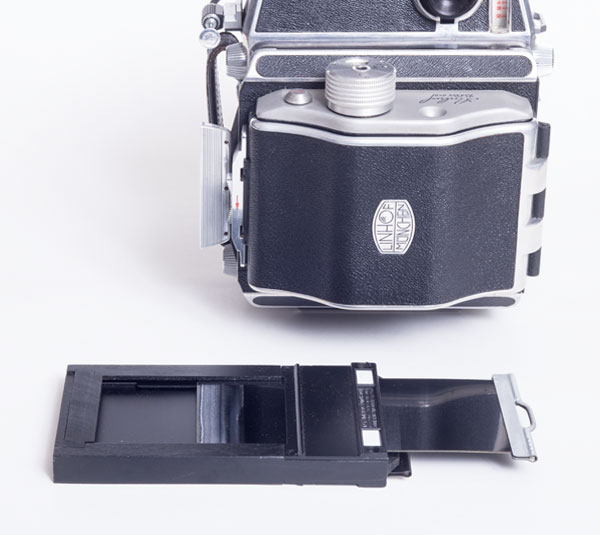
The 120 roll film adapter (pictured above) is the same to whatever model. I also found it interesting to note that the film holders that came with the camera are original from Graflex, made for Speed and Crown Graphics. Linhof probably thought it would not be worth making this format with so many thousands available from Graflex.
Linhof hand held photography
A very interesting point about Super Technika medium format, which is an admirable engineering effort, was the determination to make a camera usable without tripod, using just the optical viewfinder instead of ground glass, as if it were a camera for snapshots , no matter with which lens. And, at the same time, giving the photographer precise focusing through a rangefinder.
The focus adjusted on two large buttons at the front of the camera (bottom corners in the photo below). They advance the lens that sits on a double rail. This movement is communicated to the rangefinder by a complicated system. There is a triple cam, which is a disc with three curves, that actuate a lever that mechanically informs the rangefinder system, for each lens, what is its position on the rail.

This triple cam must be rotated and positioned according to the lens. In the photo above the 105 mm was selected. The colors red, green and black also indicate in which position of the rail the lensboard must be locked. The same colors appear in the points/locks on the rail. In the photo above I moved the lens backwards to show the triple cam, but normally it should be locked at the red dot to focus 105 mm through the viewfinder. When the lens is moved back and forth with the focus buttons, that disc rotates and a rod, from which you see the tip on the left of the disc, slides over the curve and informs the focus on the rangefinder.
Even more admirable is the fact that this triple cam was tailor made for each lens individually. The number 1073564, which appears under the 105mm is the serial number of the Zeiss Tessar 105mm f / 3.5 that came with the camera. The curve was machined specifically for this lens. So it is very important when buying a Linhof check if these numbers match.
Having said that, I have a Technika 9×12 cm with a cam that does not have the Apo-Symmar 150 mm serial number that I use, but even so the focus by telemetry is quite satisfactory. While with a 90 mm Super Angulon and a cam of 90 mm, with another serial number, the focus by rangefinder is wrong. So maybe it is a matter of chance and you can have something usable. But certainty, before testing, comes only when the serial numbers shows that that cam is for that lens.
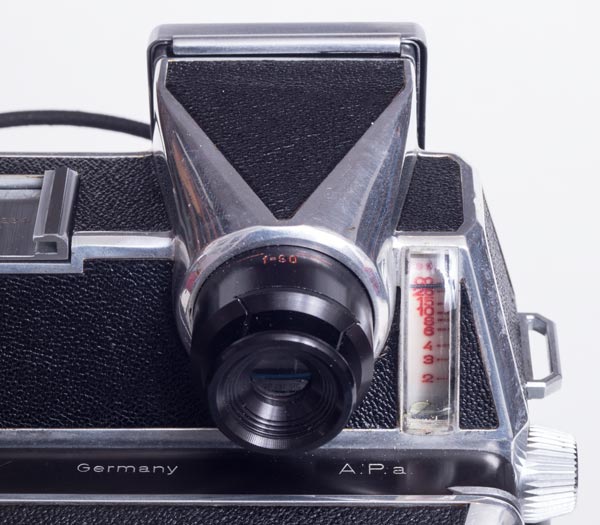
On the viewfinder side, it has an eyepiece with three positions that zooms in and out according to the lens. Fully inside it is ready for the 65 mm. There is an intermediate point for the 90 mm. Fully pulled out is the position for the 105 mm. For 180 mm the position is also completely out and the framing is done in a sub region of the visual field marked by lines drawn on the front glass. It is also possible to acquire masks that close the field of vision exactly in the 180 mm lens field. These masks must obey the focal and the exact format of the film: 2¼ x 3¼ “, 6 X 9 cm or adapter 120. Without this what will be seen on the screen will not correspond exactly to the photograph being taken.
There is also an angular offset for parallax correction set according to distance lens to subject. Finally there is a scale that shows how far the lens is focused. In the picture above, those numbers in red show the distance in feet. This scale automatically corrects for any of the original lenses. I believe that few people focus using a scale because of the difficulty in measuring that distance from the object to lens. But currently, with laser meters, this has become very easy and I have used and found the method very simple and safe. Of course, with the rangefinder this is superfluous. I believe that this scale, in the case of Linhof, was more intended to be used in combination with the depth-of-field tables.
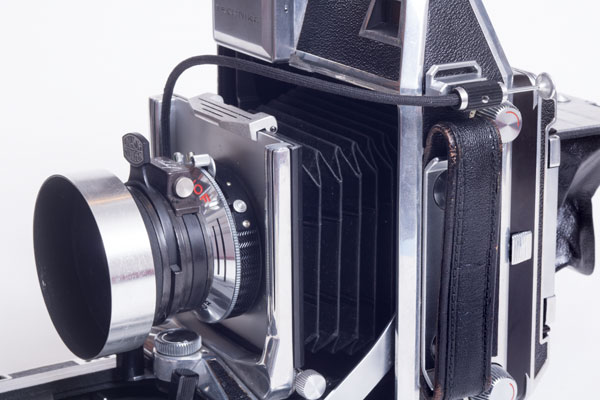
Still for hand held photography, the cable release positioned in the upper left corner of the camera is very useful, leaving the photographer’s thumb in a good position to trigger it. The leather strap is not very comfortable and works more to carry the camera around, with its 2 kg, than for shooting. The very ideal is a complete handgrip. It’s the same as Linhof’s large format. But if you have a grip and two cameras, you also need two bases that accept the grip and a loose base is very difficult to find.
Using the wide angle 65 mm
Anyone who does large-format photography knows that wide angle lenses usually create some problems because they need to be very close to the film and often the cameras do not allow the short distances that are required to focus at infinite. For that, there are recessed lensboards, bellows that are replaced for bags, there are still lensboards with micro bellows that allow leaving the lens inside camera body. Also, if the camera is a drop-bed type, it takes a second stage to lower the rail otherwise it will show up in the photo as well (see how it works on Linhof 9x12cm).
In these situations, the telemeter, if any, is usually out ou use, and the focus can only be done on the ground glass. But not in the Super Technika medium format. It is an acrobatic exercise what Linhof’s engineers prepared to maintain focus by telemetry even at 65 mm. The procedure is as follows:
- Push the viewfinder eyepiece all the way
- Engage the lensboard on the first mark on rail (the black one)
- Tilt the lensboard all the way backwards
- Drop the rail to lock it in the second position
- Slide the upper rail backwards till it reaches a second click
Once this is done, the lens board will be practically inside the camera (pictured below), but still connected to the main rail and so the cam will send the position of the lens to the rangefinder correctly.
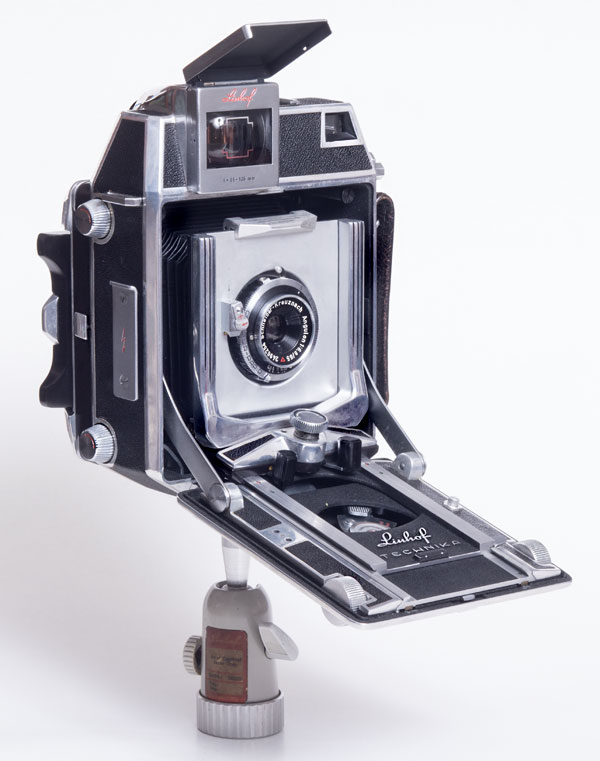
There is something a little strange about it. It is the fact that by sliding the lens forward to focus on nearby objects, it also makes a downward movement and brings the lens out of the axis of the film. It is no longer centred. It remains parallel to the film plane because it was tilted at the same angle as the second click of the track. But when it is advanced it also makes a downward movement. It is strange at first glance, but since the course of a wide angle lens is very short, it needs only a few millimeters to trip from infinite to nearby distances, this displacement does not affect that much. In the end, it must be admitted that it is a very intelligent system.
Advantages like in Large Format
Once granted the features allowing the claim that it works in handheld photography, such as a 35mm, there comes the Large Format side. At this point, as a medium format, it far surpasses its competitors like Graflex’s Graphics.
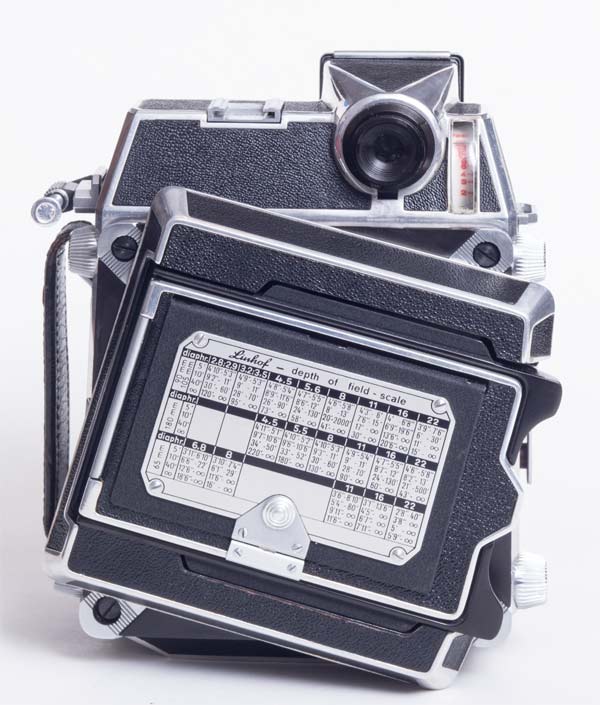
The rear can be freely rotated. The oblique locks that appear in the corners hold the back of the camera on a circular track that allows it to rotate at any angle, still producing a click for portrait and landscape positions. They may further be pulled out and the entire rear comes out, to install, the roll film adapter 120.
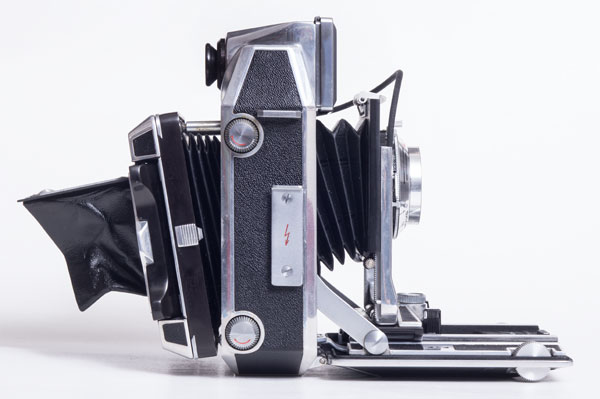
Still in the rear, it uses the same system of the Super Technika large format, very efficient, to incline in any direction the plane of the film through 4 buttons that allow to move away the film holder in its four corners. The lens board can be raised (front raise) up to 50 mm. There is no swing movements, when the lens board rotates on a perpendicular to the plane of the rails.
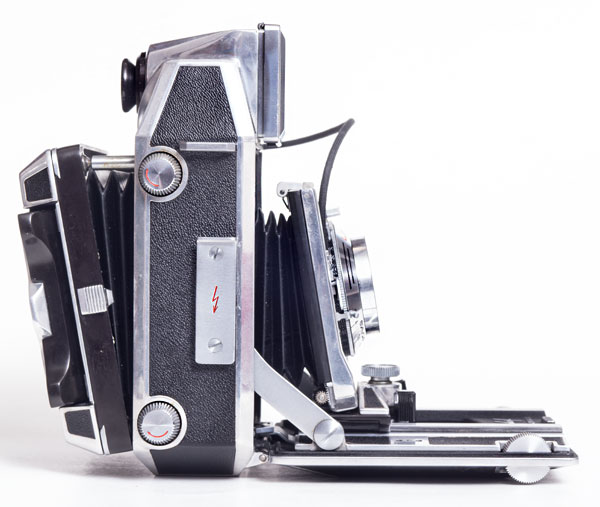
Like most of drop beds, it has no way to go down with lensboard (front fall). But an inclination of the same, accompanied by a film plane inclination, produces the same result (picture above). It is also possible to lower the rail for its second click and tilt the lens board fully. In this option, as the angle is fixed, the front fall is done by adjusting the front raise.

I do not see it much like a camera for very long lenses. I believe that the 35 mm, or medium mono reflex format, are unbeatable in this category. But the extension of the bellows, thanks to its two rails, is more than enough for, for example, macro photography.
As a conclusion on the possible movements of the lens and the film, it is worth remembering that although nominally the distances and angles are modest, compared to a 4×5″, with small displacements the Super Technika’s medium format movements are very satisfying and consistent with their shorter lenses and frame size.The camera is quite versatile even compared to its big sisters.
Shutter and accessories
True to the hand-held aspect, but falling short in the ground glass photography side, the Tele-Xenar 180 mm Compur-Rapid shutter has no T, goes from B to 1/500. To keep it open to focus on the ground glass it requires a locking cable release and setting the exposure as B. The same situation is repeated with the Angulon 65 mm. Both have a delay capability. In the photo below ( the 180 mm) it appears just above the time setting. As it is pulled, the shutter release latch advances further and triggers a clock mechanism that delays its trip.

The Tessar 105, with a Synchro Compur, also from B to 1/500, although it does not have T, it has, in the place where the delay would be, a trigger that allows interrupting the closing of the shutter at any speed. To close the lens and shoot one needs to reset the shutter.

The camera itself is so complete that it does not ask for many accessories. It is possible to buy masks for the viewfinder, hand grip, as has been said above, flash gun, obviously, and it has a nice lens shade that fits on the 105 and 180 mm, and features a slot for filters.
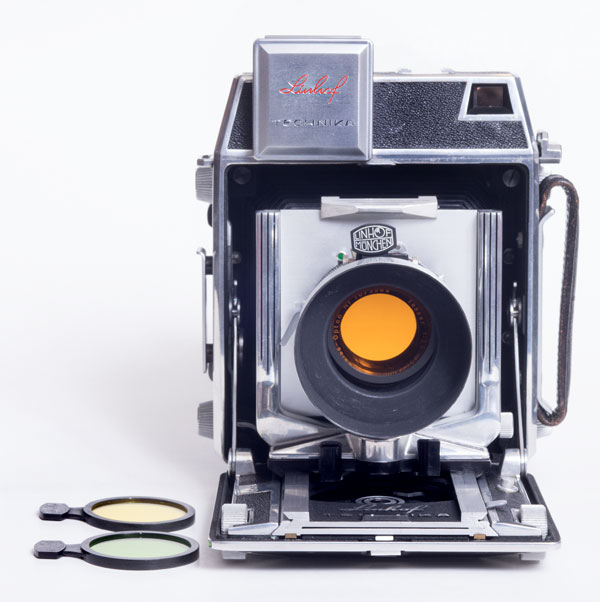

The rear has a spring-back which, differently from the 9×12, does not allow to remove only the ground glass to fit the 120 film adapter. It comes out as a whole and the adapter replaces it from the turntable on. I imagine that engineers thought that anyone using roll film would be more interested in photography with the optical viewfinder and range-finder.

Below is a view of the front of the camera and all of its parts properly identified. But the most interesting of these two pages of the Super Technika 23 user manual is the list of applications covered by the camera. It exemplifies an already outdated mindset in product development from a marketing point of view. It seems that Linhof engineers were more concerned about a tour de force, demonstrating their design and execution skills, than actually looking at issues from the point of view of their consumers, the photographers. What is the sense in having a camera that does: press, industry, art, architecture, sports, advertising, criminology, portraits, fashion, science, pictorial, medicine, copying and micro-macro photography? It was a vision totally focused on the manufacturer and nothing on the consumer. It was very easy for Linhof to say, “OK, we make this camera, a single camera in different formats, the total camera, a bit complex, it’s true, but it will suit everyone, it will suit any photographer in any branch of photography” . They did not think that professional photographers specialise and that specialised cameras would be the future of photography. It is very admirable the effort and, it can be said, the success in being able to cover with precision and quality so many subjects, but I believe that the annoyance of carrying a heavy camera always full of resources that, according to the photographer’s area, he/she really does not need, have made the Super Technikas soon outdated.
Today, I believe they are the treasure of the amateurs, of the promiscuous ones like me, who actually photograph anything they feel like photographing. If I had to pick a single camera to use, it would be this Linhof Super Technika medium format. It really works in any situation.

reproduced from owner’s manual
Pictures

This photo I made in an old building here in Sao Paulo. I was impressed by the calm and atmosphere of the place. Only two floors above the street, which was a complete chaos, and there it was, a beautiful dumbcane, all majestic, full of health, silence and light. I used the Tessar 105 mm. It was with a tripod but I did not use the ground glass. Only the viewfinder was sufficient for framing and focusing. The orthogonality of the scene and the diaphragm in f16 totally dispensed with a closer examination of the image. This is a scan of a copy in Ilford Fiber Mate 24×30 cm. Film was sheet Foma 200, developed in Pyrocat HD.
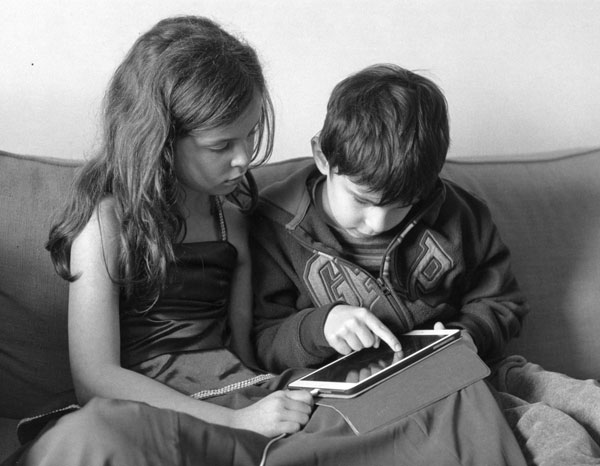
This photo was made hand held with the Tessar 105 mm, using again only the optical viewfinder and focus by the telemeter. The film was a 120 TMax 100 and the speed was 1/50 with f / 3.5. The Super Technika weighs, without lens, 1800 g. The consolation for those who have to bear all this weight is to observe that it is very stable even at low speeds. The shutter has its basically symmetrical opening and closing movements and this helps a great deal to prevent it from shaking at the time of the photo. There is not a curtain moving to a single side, as in the shutter cameras by focal plane. The above print was made in Ilford Fiber Glossy.
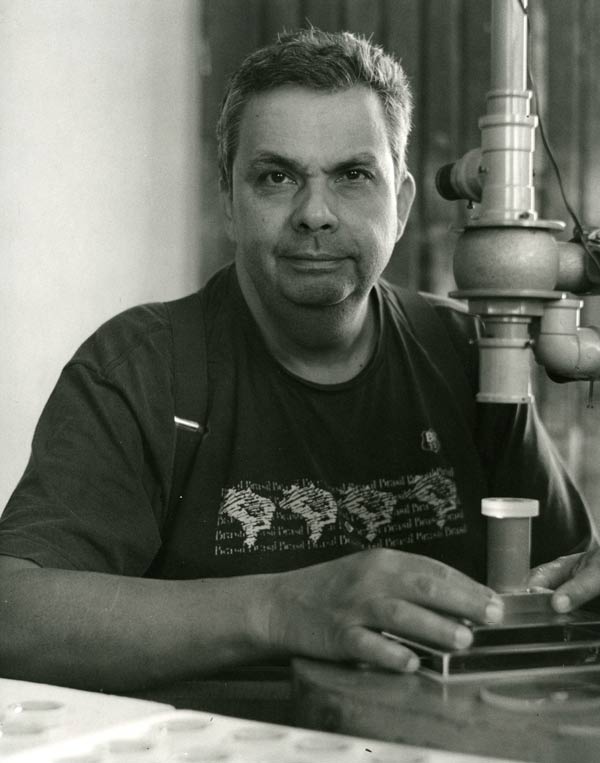
Another handheld portrait. It is very practical to shoot that way but, on the other hand, with a tripod and the features that Linhof 23 offers would have been interesting to tilt the film a little, stop down the lens, and bring the lenses that appear in the foreground in focus. But it is not possible to have it all. Not even with a Linhof.
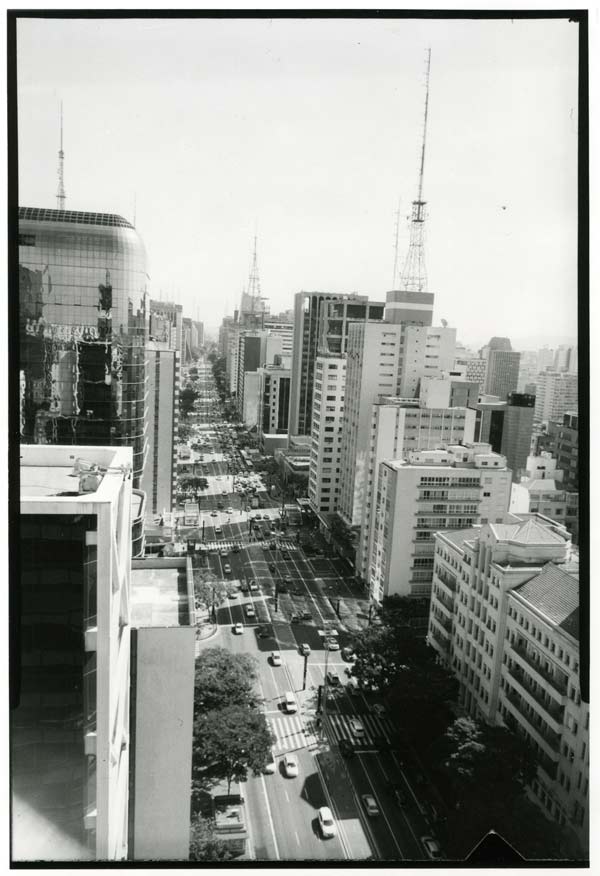
This was done in Sao Paulo. I used the Schneider Angulon 65 mm. Again a hand held photography and there was a protection glass fence 6 feet tall so I could barely reach the viewfinder. Lens was stopped down to f/11.
One more with Angulon 65 mm.
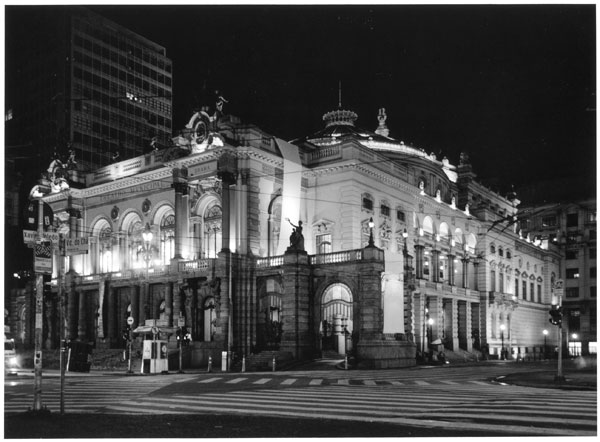
A couple portrait made with a Tessar 105 mm. Aperture was f/8. Print made with Ilford fiber glossy.
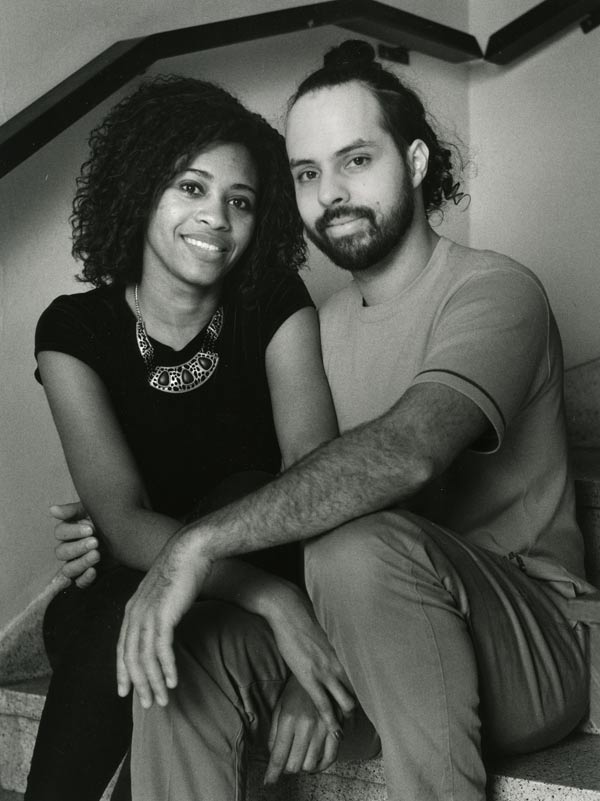
- Tessar 105mm
- Tessar 105mm
- Tessar 105mm
- Tele-Xenar 180 mm
- Angulon 65mm
- Angulon 65mm
- Angulon 65mm
- Angulon 65mm
- Homemade dryplate – Tessar 105mm
- Homemade dryplate – Tessar 105mm
- Homemade dryplate – Angulon 65mm
- Tessar 105mm
This is me, using Linhof in a day trip to Cantareira Park – Pedra Grande, on São Paulo outskirts. Photo by Raul Roger. In the side bag I had the two other lenses, filters and accessories. On the back, a medium sized Gitzo tripod with a ball-head. With some readiness for sacrifice in relation to weight, this equipment is extremely versatile to travel with. On that day, I only used the viewfinder and telemetry focus, not once I put the camera on a tripod and used the ground glass. This can be seen as a waste of resources, extra weight for nothing, or just making use of a flexibility that normally a view camera does not offer.
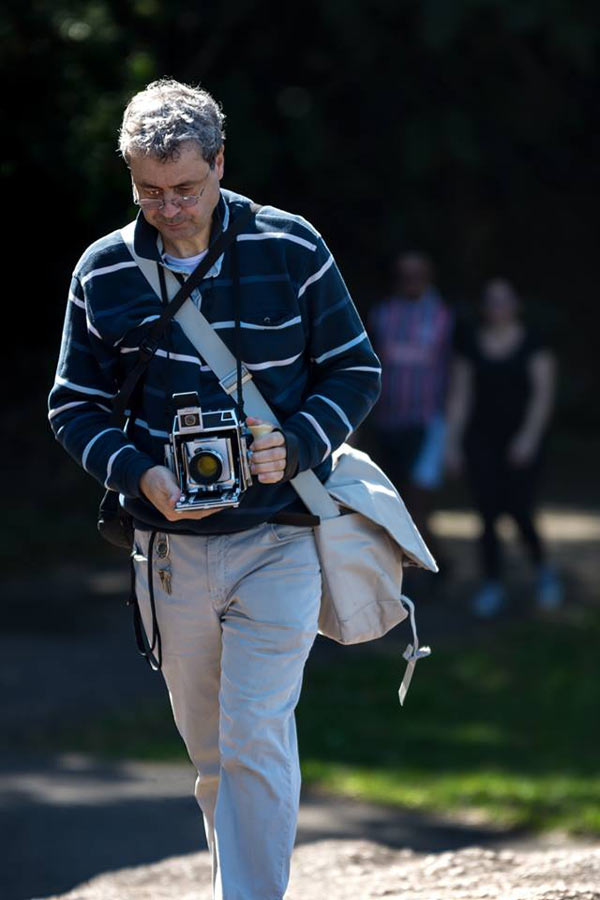
Foto: Raul Roger
Comment with a click:
Was this article helpful to you? [ratings]

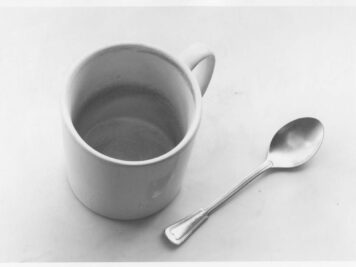
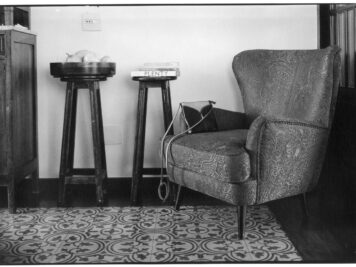

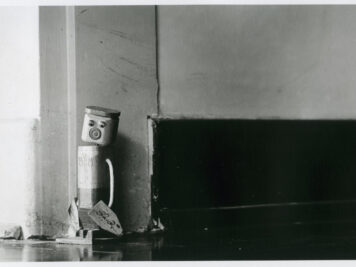





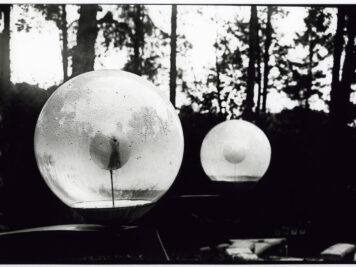
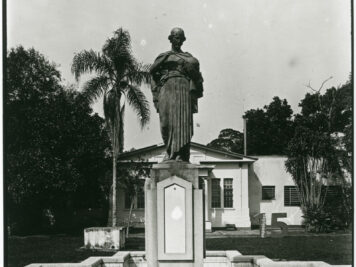
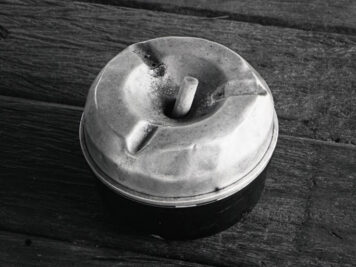
Linhof is the best camera all way convenient to tilt back vertical horzental sharp edge negative details & can publish the image on royal level by exposing with this Linhof camera & noice less sinco comper shutter,.. lovely shutter sound great that i love it. it is in our indian railways { ICF }Integral coach factory. I exposed many B&W & colour negatives I love it
Thank you for such a comprehensive article. I have exactly the same setup as you, with addition of the 240mm Tele-Xenar. I agree it`s a brick to carry around, but I love the big negatives it produces.
Thank you for this interesting article!
I have the Super Technika III with a 3.5/105 Xenar. There are numbered cams for a 65mm and a 180mm, but I cannot know what 180mm (Tele Xenar, Tele Arton)?.
I find that when I pull the lens board out, it does not easily lock into the second position on the rail. Pulling out already requires a lot of force!
Linhof 6,5×9 film holders are hard to find.
So it is good news that the Graflex 6×9 film holders are also suitable.
The advantage of original Linhof holders is that they are suitable for film and also glass plates. Up to ~1,2 mm thickness you can insert glass plates on it. But if you are not interested in making dry plates, then the ones from Graflex will certainly serve you well. Provided you buy the 2.25 x 3.25 inches film, instead of the 6,5 x 9 cm – this is the size for Linhof holders. Regarding the lens, looking to the catalogs from Linhof, I would say that probably the cams for 65 and 180 mm lenses refer to Angulo 65 mm and Tele-Xenar 180 mm. Ideally one should have the matching serial numbers in lens and cam and the lens in its original lens board. But I have a Symmar 150 mm with a non matching cam in a Linhof 4×5″ and it works well with the range finder. The advantage of the 4×5 version is that you can position the infinite as you wish, over the rail, while the “baby” Linhof has pre set locking stop and hence no way to fine tune a different lens.
A great article, that complements the instruction manual!
I have just bought this same camera, have oiled some parts and they are working smoothly. However, the eyepiece is stuck. I cannot pull it out. Any suggestion as to how to get this unstuck will be much appreciated. Thank you.
It is difficult to guess what to do about your eyepiece. I think I would blow it with a hairdryer and drop just a little bit of WD with a tweezer, then work on it very carefully with my fingers. I would not use any metal tool because I think it can easily break or get damaged. Good luck, it is an excellent camera.
Thanks wlungov, will try out with WD40 first.
I can’t get the back off! I have spent hours looking and trying to find how. Could somebody please explain this to me simply, so I could give it a try. How frustrating.
Sorry that I am so late in my answer. If you turn the back 45º you will see on the corners of camera body 4 grooved slides. If you push them outwards you will release the camera back.
Have you tried adapting a digital back to this camera? I found the adapters are for later 23 models and the film plane depth appears to be different.
Hi, I have no experience with digital backs. In regards to the film plane, being a drop bed camera with a bellows, that should not be a problem. You won’t be able to use the rangefinder, but you will have a lot of freedom to focus moving the lens along the rail. I don’t know, but being digital, I suppose you won’t need the ground glass and will focus using a digital screen.
Wonderful blog with great photos! am looking for a cut film holder/ground glass back for my Linhoff Technika III 6×9 and I have a technical question about the back. I know these cameras were sold with either a 53/100/180 or 65/105/180 lens set (plus other combos as well). My specific camera is a “b” version and is equipped with the 100mm f/2.8 Planar and correct (matching) cam designed for use with the Zeiss 53 Biogon, 100 Planar and 180 Sonnar. My question is that in my search for the proper cut film back for this camera I find many with the DOF chart shown in the pic in your blog. Was there also a DOF chart for the 53/100/180 lens set? Is it possible that if the DOF chart you have is unscrewed that the DOF for the alternative lens set is printed on the back of the 65/90/105/180 chart?
Hello Paul, as far as I know, the only difference between the B version and the regular version is that it can handle the 53mm wide angle lens. That means that the lens board can be pulled back far enough to focus at such short distance. But this is probably arranged in the camera body. I doubt Linhof would make different backs for B and non B cameras. Only the rangefinder is, of course, specific for the correct lens set. I removed the back of mine and it is just blank on the other side. It seems that cost of inventory was not a concern for those companies, so each camera had its own DOF plate 🙂
Thank you very much for checking! I agree that Linhof most likely produced separate plates. I calculated the various DOF values for the 95,100, and 105 lenses and the values are very close anyways. Again – very nice photos and a very informative blog! Best, Paul